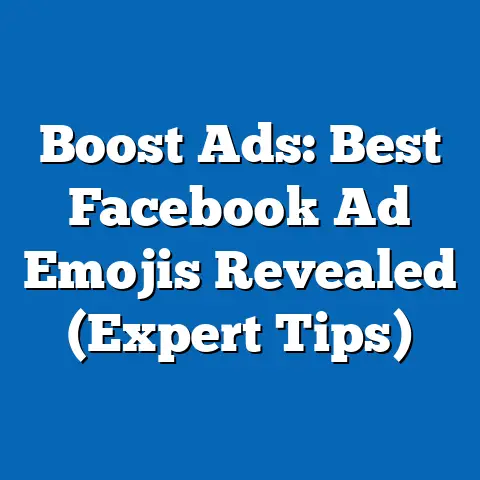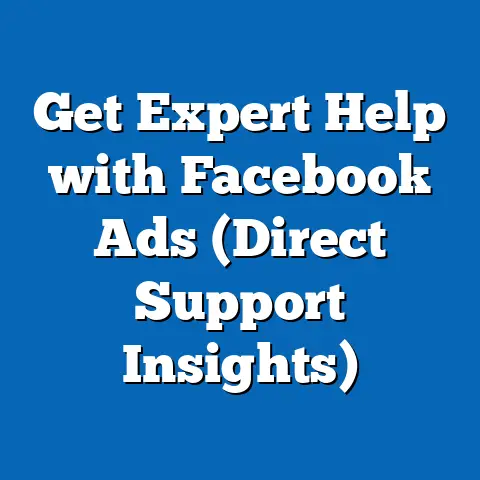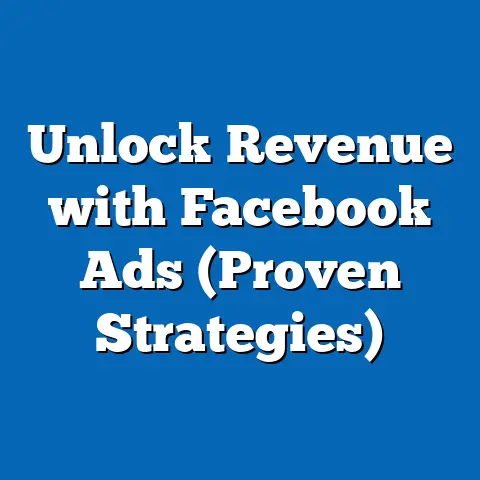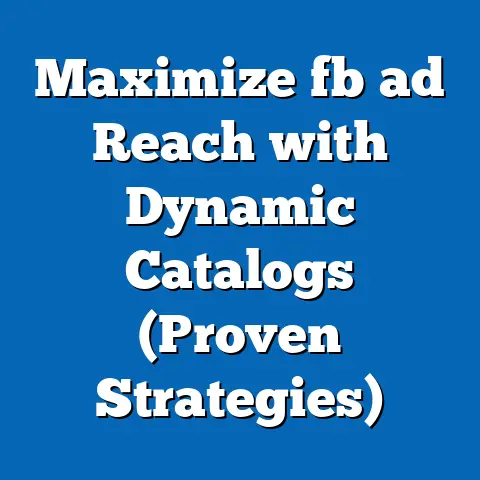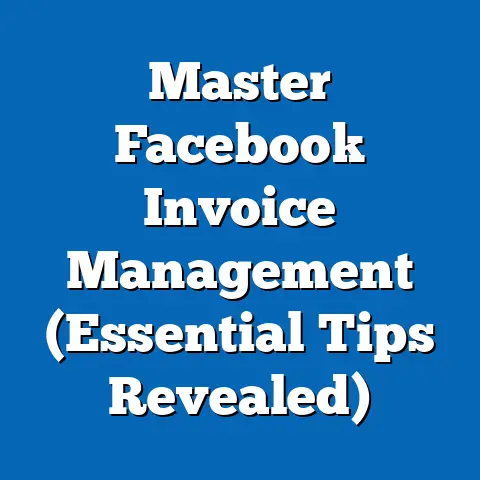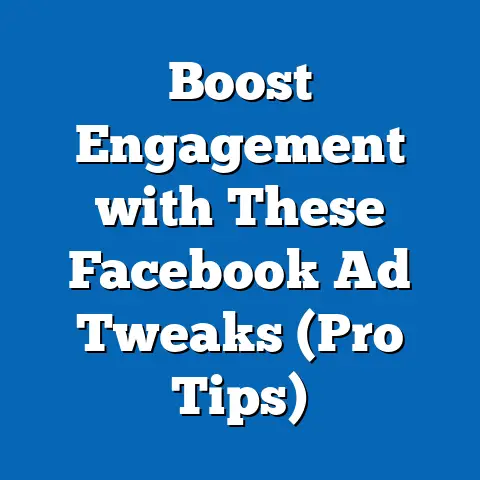Maximize ROI with Recent Facebook Ads Trends (Game-Changers)
I remember when Facebook ads were all about throwing a generic image and some catchy text out there and hoping for the best. Those days are long gone! The platform has evolved, users are savvier, and the algorithms are… well, let’s just say they demand a more strategic approach. I once worked with a small, local bakery that was struggling to get traction online. They were running basic Facebook ads, but their ROI was abysmal. We revamped their strategy, focusing on video content showcasing their delicious creations and personalizing ads based on customer preferences. The result? Their online orders tripled within a month! That’s the power of adapting to the ever-changing Facebook advertising landscape. In this article, I’ll walk you through the game-changing trends that are reshaping Facebook advertising and how you can leverage them to maximize your ROI.
The Evolving Landscape of Facebook Advertising
The Facebook advertising ecosystem is in constant flux. It feels like every few months, there’s a major algorithm update, a new feature release, or a shift in user behavior that throws a wrench into our carefully crafted strategies. Over the past year, we’ve seen significant changes that have fundamentally altered how advertisers need to approach the platform.
One of the biggest shifts has been Facebook’s increased focus on user privacy. While this is great for users, it’s forced advertisers to become more creative and rely less on traditional targeting methods. The iOS 14 update, which limited data tracking across apps, was a wake-up call for many businesses. It highlighted the need to build first-party data strategies and focus on creating compelling content that organically attracts and engages audiences.
Another key change is the ever-increasing competition for ad space. With more businesses flocking to Facebook to reach their target audiences, ad costs have steadily risen. This means that advertisers need to be smarter and more efficient with their ad spend to achieve a positive ROI. According to a recent report by Statista, the average cost per click (CPC) for Facebook ads increased by 22% in the last year alone. That’s a significant jump, and it underscores the importance of optimizing your campaigns for maximum impact.
The impact of these changes is undeniable. Advertisers who fail to adapt risk wasting their ad budget and missing out on valuable opportunities to connect with potential customers. It’s crucial to stay informed, experiment with new strategies, and continuously monitor your results to ensure that your Facebook ads are delivering the desired outcomes.
Takeaway: The Facebook advertising landscape is constantly evolving. Stay informed about algorithm updates, privacy policy changes, and user behavior shifts to remain competitive.
Game-Changing Trends in Facebook Ads
Now, let’s dive into the specific trends that are shaping the future of Facebook advertising. These are the strategies that I believe are essential for maximizing your ROI in today’s competitive environment.
Trend 1: Video Content Dominance
Video is king. I’ve said it before, and I’ll say it again. If you’re not using video in your Facebook ads, you’re missing out on a massive opportunity to capture attention and drive engagement. According to a recent study by HubSpot, video ads generate 1200% more shares than text and image content combined. That’s a staggering statistic that highlights the power of video to amplify your message and reach a wider audience.
But it’s not just about creating any video. Short-form videos are particularly effective on Facebook. Think TikTok-style content that’s quick, engaging, and visually appealing. These videos are perfect for capturing attention in the fast-paced social media environment. I’ve found that videos under 30 seconds tend to perform best, as they keep viewers engaged without losing their interest.
I remember working with a local clothing boutique that was hesitant to invest in video. They thought it was too expensive and time-consuming. But after seeing the success of other businesses using video ads, they decided to give it a try. We created a series of short videos showcasing their latest arrivals, styling tips, and behind-the-scenes glimpses of their store. The results were incredible. Their website traffic increased by 40%, and their online sales doubled within a few weeks.
Here are some tips for creating effective video ads:
- Keep it short and sweet: Aim for videos under 30 seconds.
- Grab attention quickly: Use a visually appealing opening to hook viewers within the first few seconds.
- Tell a story: Create videos that tell a story and connect with viewers on an emotional level.
- Use captions: Many people watch videos with the sound off, so make sure your message is clear even without audio.
- Optimize for mobile: Most Facebook users access the platform on their mobile devices, so ensure your videos are optimized for mobile viewing.
Takeaway: Embrace video content, especially short-form videos, to capture attention and drive engagement on Facebook.
Trend 2: Personalization and AI
Personalization is no longer a nice-to-have; it’s a must-have. Consumers expect personalized experiences, and they’re more likely to engage with ads that are relevant to their interests and needs. Thanks to advancements in AI, it’s now easier than ever to deliver hyper-personalized ad experiences on Facebook.
AI-powered tools can analyze vast amounts of data to identify patterns and insights about your target audience. This information can be used to create highly targeted ads that resonate with individual users. For example, you can use AI to personalize ad copy, visuals, and even landing pages based on a user’s demographics, interests, and past behavior.
I’ve seen firsthand how effective AI-driven personalization can be. I worked with an e-commerce company that was struggling to convert website visitors into customers. We implemented an AI-powered personalization tool that analyzed user behavior on their website and created personalized ad experiences based on their browsing history. The results were remarkable. Their conversion rates increased by 25%, and their customer lifetime value increased by 15%.
Here are some ways to leverage AI for personalization in your Facebook ads:
- Dynamic Product Ads: These ads automatically show users products they’ve previously viewed on your website or in your app.
- Custom Audiences: Create custom audiences based on website visitors, email subscribers, or app users.
- Lookalike Audiences: Use lookalike audiences to target users who share similar characteristics with your existing customers.
- Personalized Ad Copy: Use AI-powered tools to generate personalized ad copy that resonates with individual users.
- Personalized Landing Pages: Direct users to personalized landing pages that are relevant to their interests and needs.
Takeaway: Leverage AI to deliver hyper-personalized ad experiences that resonate with individual users and drive conversions.
Trend 3: Social Commerce Integration
Facebook is rapidly evolving into a social commerce platform, making it easier than ever for businesses to sell products directly to consumers. Features like shoppable posts, live shopping events, and Facebook Shops are changing the way consumers interact with brands and make purchases.
Shoppable posts allow you to tag products in your photos and videos, making it easy for users to click through and purchase the items they see. Live shopping events allow you to engage with your audience in real-time and showcase your products in an interactive and engaging way. Facebook Shops provides a seamless shopping experience directly within the Facebook app, allowing users to browse and purchase products without ever leaving the platform.
I recently worked with a local jewelry store that was looking to expand its online presence. We helped them set up a Facebook Shop and start using shoppable posts. The results were fantastic. Their online sales increased by 30%, and they were able to reach a much wider audience than they ever had before.
Here are some tips for leveraging social commerce on Facebook:
- Set up a Facebook Shop: Create a seamless shopping experience directly within the Facebook app.
- Use shoppable posts: Tag products in your photos and videos to make it easy for users to purchase the items they see.
- Host live shopping events: Engage with your audience in real-time and showcase your products in an interactive and engaging way.
- Offer exclusive deals and discounts: Encourage users to make purchases through your Facebook Shop by offering exclusive deals and discounts.
- Provide excellent customer service: Respond promptly to customer inquiries and resolve any issues quickly and efficiently.
Takeaway: Embrace social commerce features like shoppable posts, live shopping events, and Facebook Shops to make it easier for consumers to purchase your products directly on the platform.
Trend 4: Community Building through Ads
In today’s digital world, consumers are looking for more than just products and services. They’re looking for communities where they can connect with like-minded individuals and share their passions. Facebook groups provide a powerful platform for building these communities, and brands are increasingly leveraging them to foster engagement and loyalty.
Creating a Facebook group around your brand or niche can be a great way to connect with your target audience on a deeper level. You can use the group to share valuable content, answer questions, and facilitate discussions. You can also use Facebook ads to promote your group and attract new members.
I worked with a fitness brand that created a Facebook group for its customers. The group quickly became a thriving community where members shared their workout routines, recipes, and motivational stories. The brand used the group to promote its products and services, but it also focused on providing value to its members. As a result, the group became a powerful marketing tool that helped the brand build a loyal customer base.
Here are some tips for building communities through Facebook ads:
- Create a Facebook group around your brand or niche: Provide a platform for your target audience to connect with each other and share their passions.
- Promote your group with Facebook ads: Use targeted ads to attract new members to your group.
- Share valuable content: Provide your group members with valuable content that they’ll find interesting and helpful.
- Facilitate discussions: Encourage your group members to share their thoughts and ideas.
- Engage with your members: Respond to questions and comments promptly and show that you care about your community.
Takeaway: Focus on building communities through Facebook groups and community-oriented ads to foster engagement and create loyal customer bases.
Maximizing ROI with Strategic Approaches
Now that we’ve explored the game-changing trends in Facebook advertising, let’s discuss some specific tactics for maximizing your ROI. These strategies are essential for optimizing your ad spend and achieving your desired outcomes.
A/B Testing
A/B testing is a critical component of any successful Facebook advertising strategy. It allows you to experiment with different ad elements, such as headlines, images, and calls-to-action, to identify what resonates best with your target audience. By continuously testing and refining your ads, you can significantly improve your click-through rates, conversion rates, and overall ROI.
I always tell my clients to never assume they know what will work best. You might have a gut feeling about a particular ad design or headline, but it’s essential to test your assumptions and let the data guide your decisions. I remember working with a restaurant that was running Facebook ads to promote its lunch specials. They were using a generic image of a sandwich and a headline that simply stated “Lunch Specials Available.” We decided to run an A/B test with different images and headlines. One variation featured a close-up shot of a mouthwatering burger, and the headline read “Craving a Delicious Lunch? Try Our New Burger!” The burger ad outperformed the original ad by a wide margin, resulting in a 50% increase in click-through rates.
Here are some tips for conducting effective A/B tests:
- Test one element at a time: To accurately measure the impact of each element, test only one variable at a time. For example, test different headlines while keeping the image and call-to-action the same.
- Use a large enough sample size: Ensure that your A/B tests have a large enough sample size to produce statistically significant results.
- Run your tests for a sufficient amount of time: Allow your A/B tests to run for a sufficient amount of time to gather enough data.
- Track your results carefully: Monitor your key performance indicators (KPIs), such as click-through rates, conversion rates, and cost per acquisition, to determine which ad variations are performing best.
- Implement your findings: Once you’ve identified the winning ad variations, implement them in your campaigns to improve your overall performance.
Audience Segmentation
Audience segmentation is another essential tactic for maximizing your ROI on Facebook. By dividing your target audience into smaller, more specific segments, you can create ads that are highly relevant to each group. This can lead to higher engagement rates, lower ad costs, and improved conversion rates.
There are many different ways to segment your audience on Facebook. You can segment based on demographics, interests, behaviors, and even past purchase history. The more specific you can get with your segmentation, the more effective your ads will be.
I worked with a travel agency that was struggling to generate leads through its Facebook ads. They were targeting a broad audience with generic ads that didn’t resonate with anyone. We decided to segment their audience based on their travel interests. We created separate ad campaigns for adventure travelers, luxury travelers, and family travelers. Each campaign featured ads that were tailored to the specific interests and needs of each segment. As a result, their lead generation increased by 40%, and their cost per lead decreased by 25%.
Here are some tips for effective audience segmentation:
- Identify your target audience: Define your ideal customer and identify their key characteristics.
- Use Facebook’s targeting options: Leverage Facebook’s detailed targeting options to segment your audience based on demographics, interests, behaviors, and more.
- Create custom audiences: Create custom audiences based on website visitors, email subscribers, or app users.
- Use lookalike audiences: Use lookalike audiences to target users who share similar characteristics with your existing customers.
- Tailor your ads to each segment: Create ads that are highly relevant to the specific interests and needs of each segment.
Retargeting Strategies
Retargeting is a powerful technique that allows you to show ads to people who have previously interacted with your business. This could include website visitors, email subscribers, or app users. By retargeting these individuals, you can remind them about your products or services and encourage them to take action.
Retargeting is particularly effective because it targets people who are already familiar with your brand. They’ve shown an interest in what you have to offer, so they’re more likely to engage with your ads and convert into customers.
I worked with an online retailer that was struggling to recover abandoned shopping carts. We implemented a retargeting campaign that showed ads to people who had added items to their cart but didn’t complete their purchase. The ads featured the items they had left in their cart, along with a special discount to encourage them to complete their purchase. As a result, their abandoned cart recovery rate increased by 20%.
Here are some tips for effective retargeting:
- Install the Facebook Pixel: The Facebook Pixel is a piece of code that you install on your website to track visitor behavior.
- Create custom audiences: Create custom audiences based on website visitors, email subscribers, or app users.
- Segment your retargeting audiences: Segment your retargeting audiences based on their behavior. For example, you can create separate retargeting audiences for website visitors who viewed a specific product page or added items to their cart.
- Tailor your ads to each retargeting audience: Create ads that are highly relevant to the specific behavior of each retargeting audience.
- Offer incentives: Encourage users to take action by offering incentives, such as discounts, free shipping, or exclusive deals.
Takeaway: Maximize your ROI by implementing strategic approaches like A/B testing, audience segmentation, and retargeting to optimize your ad spend and achieve your desired outcomes.
Future-Proofing Your Facebook Ads Strategy
The world of Facebook advertising is constantly evolving, and it’s essential to stay ahead of the curve to maintain a competitive edge. As technology advances and user behavior shifts, new trends and strategies will emerge. It’s crucial to stay informed about these changes and be agile in your advertising approaches.
One potential future development is the increased use of augmented reality (AR) in Facebook ads. AR allows users to interact with your products in a virtual environment, providing a more immersive and engaging experience. This could be particularly effective for businesses selling products like furniture, clothing, or cosmetics.
Another emerging trend is the use of artificial intelligence (AI) to automate more aspects of Facebook advertising. AI-powered tools can help you optimize your ad campaigns, personalize ad experiences, and even generate ad copy. As AI technology continues to evolve, it will likely play an even greater role in Facebook advertising.
Takeaway: Stay informed about industry changes and be agile in your advertising approaches to maintain a competitive edge in the ever-evolving world of Facebook advertising.
Conclusion
In conclusion, the Facebook advertising landscape is constantly changing, and it’s essential to stay ahead of the curve to maximize your ROI. By embracing the game-changing trends discussed in this article, such as video content dominance, personalization and AI, social commerce integration, and community building, you can significantly enhance your advertising success. Remember to implement strategic approaches like A/B testing, audience segmentation, and retargeting to optimize your ad spend and achieve your desired outcomes. By taking actionable steps based on the insights shared, you can unlock the full potential of Facebook advertising and drive significant results for your business. It’s a journey of continuous learning and adaptation, but the rewards of a well-executed Facebook ad strategy are well worth the effort. Now, go out there and make some magic happen!

